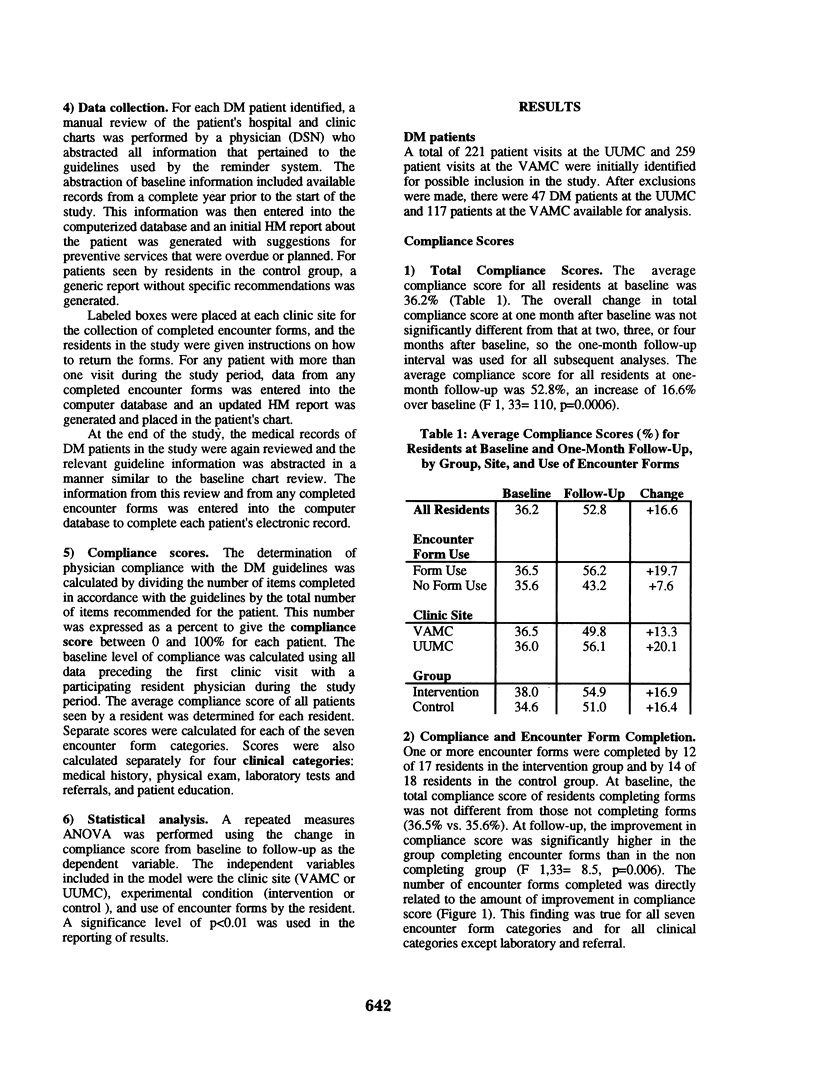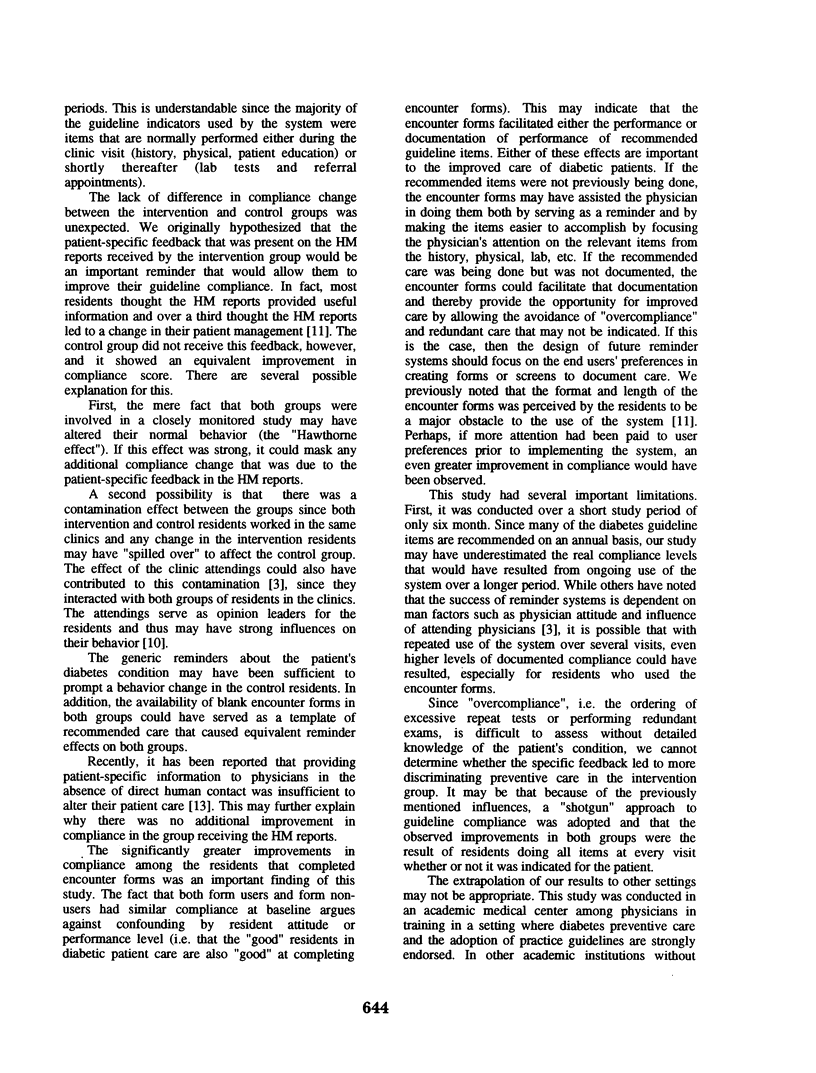Abstract
Computerized reminder systems have been shown to be effective in improving physician compliance with preventive services guidelines. Very little has been published about the use of computerized reminders for preventive care in diabetes. We implemented a computer-generated reminder system for diabetes care guidelines in a randomized controlled study in the outpatient clinics of 35 internal medicine residents at the University of Utah and Salt Lake Veterans Affairs Hospitals. After a six month study period, compliance with the recommended care significantly improved in both the intervention group that received patient-specific reminders about the guidelines (38.0% at baseline, 54.9% at follow-up) and the control group that received a nonspecific report (34.6% at baseline, 51.0% at follow-up). There was no significant difference between the two groups. Both clinic sites showed similar improvement over baseline levels of compliance. Residents who completed encounter forms used by the system showed a significantly greater improvement in compliance than those who did not complete encounter forms (19.7% vs. 7.6%, p = 0.006). The improvements in guideline compliance were seen in all areas of diabetes preventive care studied, and significant improvements were seen with recommended items from the medical history, physical exam, laboratory testing, referrals, and patient education. The use of encounter forms by the providers significantly improved documented compliance with the guidelines in almost all categories of preventive care. These results suggest that computerized reminder systems improve compliance with recommended care more by facilitating the documentation of clinical findings and the ordering of recommended procedures than by providing the clinician with patient-specific information about guideline compliance status. Further study is needed to understand the implications of these findings to the development of future computerized reminder systems for chronic diseases such as diabetes.
Full text
PDF





Selected References
These references are in PubMed. This may not be the complete list of references from this article.
- Anderson R. M. The challenge of translating scientific knowledge into improved diabetes care in the 1990s. Diabetes Care. 1991 May;14(5):418–421. doi: 10.2337/diacare.14.5.418. [DOI] [PubMed] [Google Scholar]
- Deeb L. C., Pettijohn F. P., Shirah J. K., Freeman G. Interventions among primary-care practitioners to improve care for preventable complications of diabetes. Diabetes Care. 1988 Mar;11(3):275–280. doi: 10.2337/diacare.11.3.275. [DOI] [PubMed] [Google Scholar]
- Harris M. I., Eastman R. C., Siebert C. The DCCT and medical care for diabetes in the U.S. Diabetes Care. 1994 Jul;17(7):761–764. doi: 10.2337/diacare.17.7.761. [DOI] [PubMed] [Google Scholar]
- Jacques C. H., Jones R. L., Houts P., Bauer L. C., Dwyer K. M., Lynch J. C., Casale T. S. Reported practice behaviors for medical care of patients with diabetes mellitus by primary-care physicians in Pennsylvania. Diabetes Care. 1991 Aug;14(8):712–717. doi: 10.2337/diacare.14.8.712. [DOI] [PubMed] [Google Scholar]
- Lee T. H., Pearson S. D., Johnson P. A., Garcia T. B., Weisberg M. C., Guadagnoli E., Cook E. F., Goldman L. Failure of information as an intervention to modify clinical management. A time-series trial in patients with acute chest pain. Ann Intern Med. 1995 Mar 15;122(6):434–437. doi: 10.7326/0003-4819-122-6-199503150-00006. [DOI] [PubMed] [Google Scholar]
- Lobach D. F., Hammond W. E. Development and evaluation of a Computer-Assisted Management Protocol (CAMP): improved compliance with care guidelines for diabetes mellitus. Proc Annu Symp Comput Appl Med Care. 1994:787–791. [PMC free article] [PubMed] [Google Scholar]
- Lomas J., Enkin M., Anderson G. M., Hannah W. J., Vayda E., Singer J. Opinion leaders vs audit and feedback to implement practice guidelines. Delivery after previous cesarean section. JAMA. 1991 May 1;265(17):2202–2207. [PubMed] [Google Scholar]
- McDonald C. J., Hui S. L., Smith D. M., Tierney W. M., Cohen S. J., Weinberger M., McCabe G. P. Reminders to physicians from an introspective computer medical record. A two-year randomized trial. Ann Intern Med. 1984 Jan;100(1):130–138. doi: 10.7326/0003-4819-100-1-130. [DOI] [PubMed] [Google Scholar]
- Nilasena D. S., Lincoln M. J., Turner C. W., Warner H. R., Foerster V. A., Williamson J. W., Stults B. M. Development and implementation of a computer-generated reminder system for diabetes preventive care. Proc Annu Symp Comput Appl Med Care. 1994:831–835. [PMC free article] [PubMed] [Google Scholar]
- Ornstein S. M., Garr D. R., Jenkins R. G., Rust P. F., Arnon A. Computer-generated physician and patient reminders. Tools to improve population adherence to selected preventive services. J Fam Pract. 1991 Jan;32(1):82–90. [PubMed] [Google Scholar]
- Stead W. W., Hammond W. E. Computer-based medical records: the centerpiece of TMR. MD Comput. 1988 Sep-Oct;5(5):48–62. [PubMed] [Google Scholar]
- Tape T. G., Campbell J. R. Computerized medical records and preventive health care: success depends on many factors. Am J Med. 1993 Jun;94(6):619–625. doi: 10.1016/0002-9343(93)90214-a. [DOI] [PubMed] [Google Scholar]


